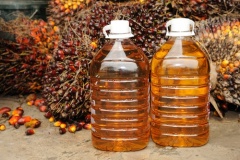Palm kernel oil
| Infobox on Palm kernel oil | |
|---|---|
| Example of Palm kernel oil |  |
| Facts | |
| Origin | This Table shows only a selection of the most important countries of origin and should not be thought of as exhaustive.
|
| Density (in t/m3) |
|
| Temperature (in oC) | See text |
| Humidity / moisture | Fats and fatty oils are insoluble in water. However, contact with water may give rise to soluble lower fatty acids and glycerol, which cause rancidity together with changes in color (yellow to brown), odor and taste as well as gelling and thickening. For this reason, the tanks must be absolutely dry after cleaning. |
| Ventilation | Ventilation must not be carried out under any circumstances, as it would supply fresh oxygen to the cargo, which would promote oxidation processes and premature rancidity. |
| Self-heating / spontaneous combustion | - |
| Risk factors | Self-heating / Spontaneous combustion, odor sensitivity, contamination and mechanical influence; see text. |
Palm kernel oil
Description
Palm kernel oil is an edible plant oil derived from the kernel of the oil palm Elaeis guineensis. It should not be confused with the other two edible oils derived from palm fruits: Coconut Oil, extracted from the kernel of the coconut, and Palm Oil, extracted from the pulp of the oil palm fruit.
Palm kernel oil, coconut oil, and palm oil are three of the few highly saturated vegetable fats. Palm kernel oil, which is semi-solid at room temperature, is more saturated than palm oil and comparable to coconut oil. Like all vegetable oils, these three palm-derived oils do not contain cholesterol (found in unrefined animal fats), although saturated fat intake increases both LDL and HDL cholesterol.
Splitting of oils and fats by hydrolysis, or under basic conditions saponification, yields Fatty Acids, with glycerin (glycerol) as a by-product. The split-off fatty acids are a mixture ranging from C4 to C18, depending on the type of oil/fat.
Resembling Coconut Oil, palm kernel oil is packed with myristic and lauric fatty acids and therefore suitable for the manufacture of soaps, washing powders and personal care products. Lauric acid is very important in soap making. A good soap must contain at least 15 per cent laurate for quick lathering, while soap made for use in sea water is based on virtually 100 per cent laurate.
Palm kernel oil is a white to yellowish oil of vegetable origin obtained from the kernels of the oil palm. It is one of the best oils.
Applications
Palm kernel oil is a common cooking ingredient; its increasing use in the commercial food industry throughout the world is buoyed by its lower cost, the high oxidative stability (saturation) of the refined product when used for frying, and its lack of cholesterol and trans fatty acids, both viewed as being heart-healthy attributes.
Palm kernel oil, like other vegetable oils, can also be used to create biodiesel for internal combustion engines. Biodiesel has been promoted as a renewable energy source to reduce net emissions of carbon dioxide into the atmosphere. Therefore, biodiesel is seen as a way to decrease the impact of the greenhouse effect and as a way of diversifying energy supplies to assist national energy security plans.
Storage / transport
Storage duration of palm kernel oil: approx. 6 months at 24°C
Loading temperature: 35°C
Favorable carrying temperature: 25°C/30°C
Pumping temperature: <50°C
Solidification temperature: approx. 25°C
Phase changes: at 25°C palm kernel oil thickens, at approx. 20°/15°C it hardens and solidifies.
The rate of heating should be no greater than 8°C/day.
The acid value of an oil may be used as a measure of quality. Palm kernel oil should have an acid value of at most 3.0 - 7.5%. The acid value of the oil must not be too high, as this indicates an excessively high content of free Fatty Acids, which causes the oil to discolour and turn sour.
Oils and fats spoil by readily becoming rancid which is promoted by light, atmospheric oxygen and moisture and leads to changes in odor and taste.
To be able to pump the oil out of the tanks, it must be at the required pumping temperature. This is only possible, however, if the oil has been kept liquid during the voyage (above a minimum temperature). Loading, travel and pumping temperatures must be precisely complied with, since any change in consistency which occurs during transport may prove irreversible. If the oil solidifies in the tanks, it cannot be liquefied again even by forced heating. In the vicinity of the heating coils, the oil melts, scorches, discolors and becomes rancid.
Pumping out may be difficult in cold weather. The oil may cool too rapidly in the long lines and solid deposits form on the outer walls, which cannot be pumped out and prevent the still liquid cargo from reaching the suction valve. This problem can be solved by appropriate heating or insulation of the lines.
Separation and the associated change in consistency from liquid to solid occurs more readily upon cooling, the higher is the solidification point. Palm kernel oil has a relatively high solidification point/range of 24 - 19°C. In its native countries it has a liquid consistency, but in temperate latitudes it is fatty and has to be heated. Palm kernel oil is therefore also known as palm kernel fat. The oils must only be heated by a few °C per day, otherwise the risk of rancidity and other negative changes arises.
For further details on deterioration, contamination, oxidation, transit and handling etc., we may refer to Bulk Oils and Fats and Fats and Oils.
Risk factors
- Self-heating / Spontaneous combustion
- Odor
- Contamination
- Mechanical influences
- Toxicity / Hazards to health
- Shrinkage / Shortage











